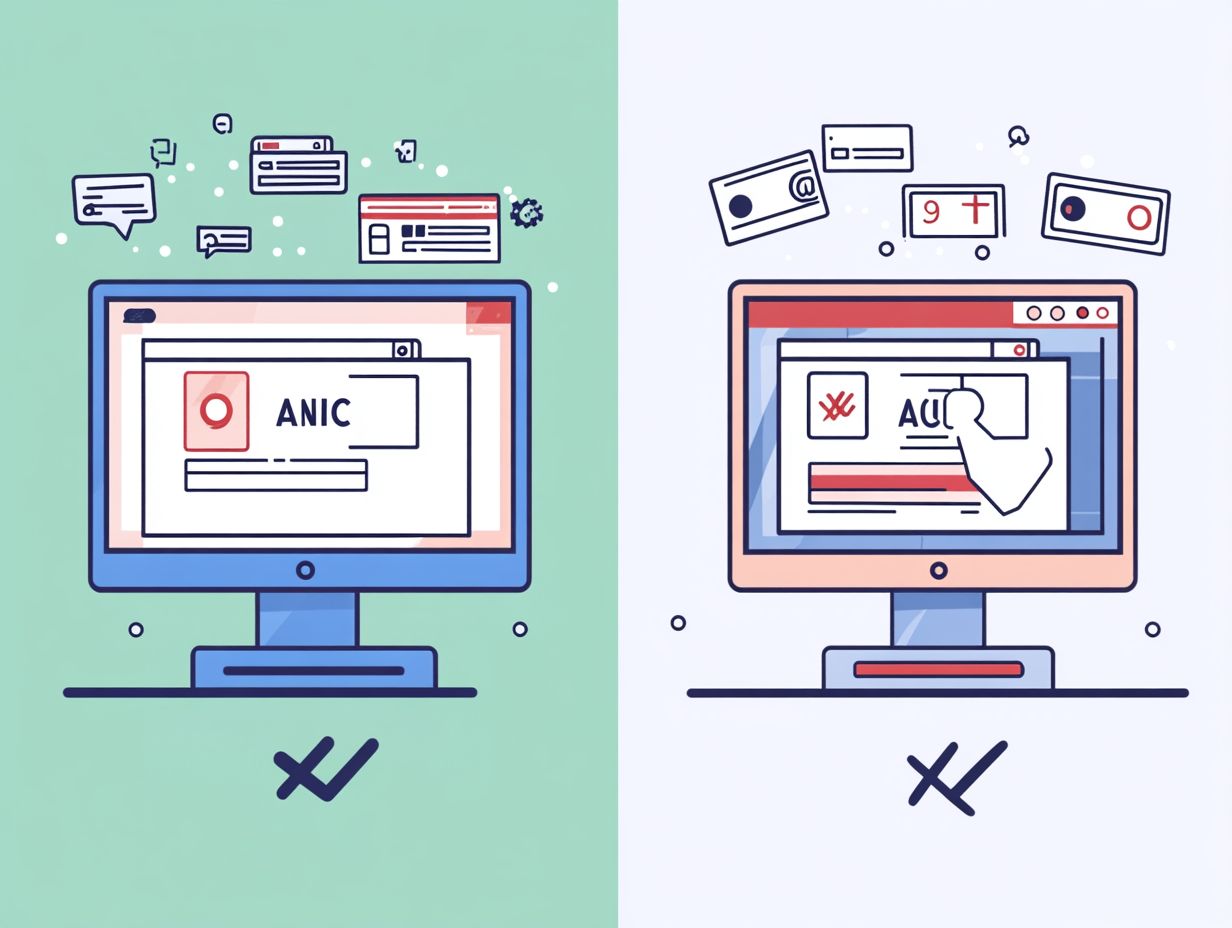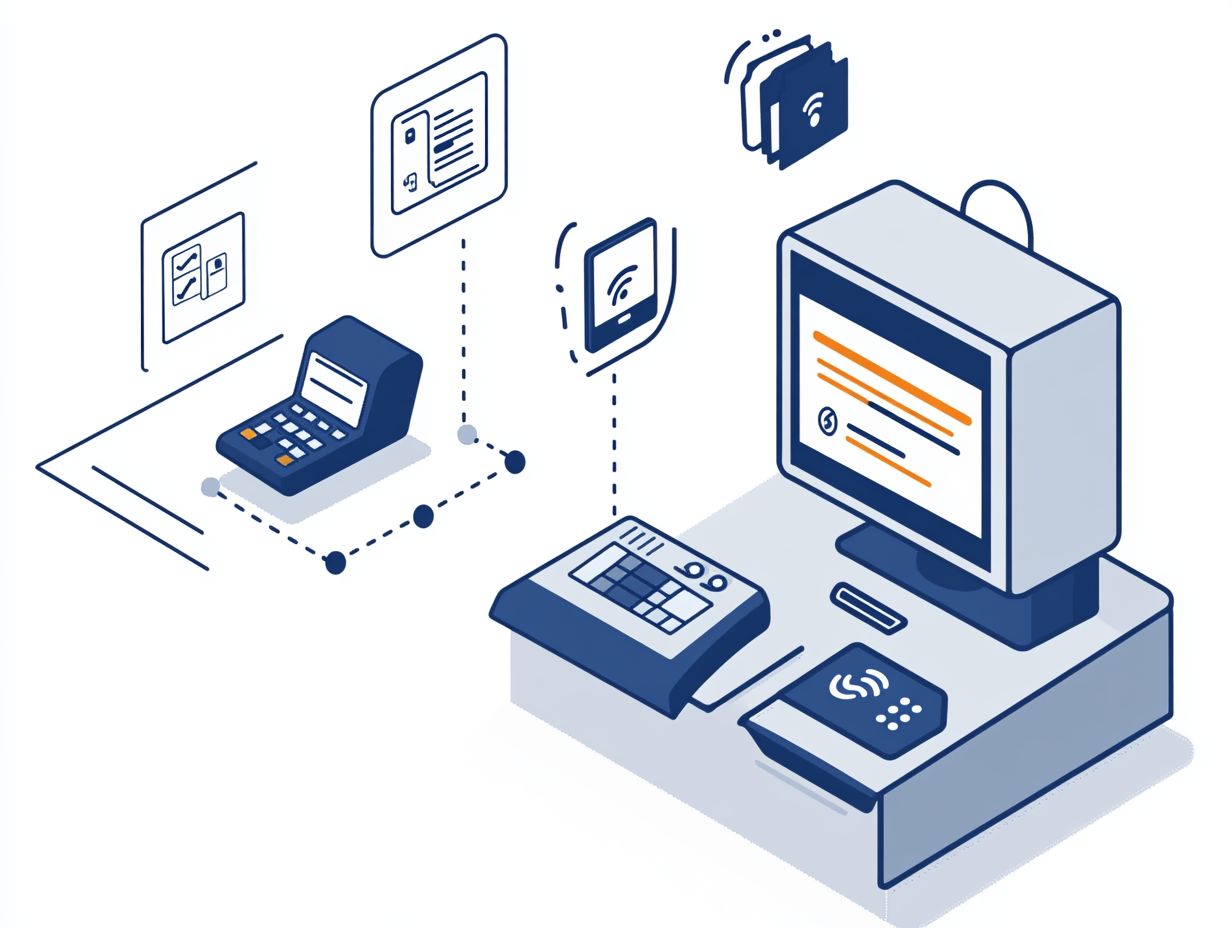In the current dynamic financial environment, selecting the appropriate payment method is essential for businesses. ACH (Automated Clearing House) and wire transfers are two widely utilized options, each possessing distinct advantages and disadvantages.
This article delineates the key differences between these payment methods, underscoring why ACH frequently stands out as the superior choice for business transactions. It examines aspects such as cost-effectiveness and security features, while also providing a comprehensive guide to the setup process. Furthermore, prevalent misconceptions regarding ACH will be addressed to facilitate well-considered choices in financial transactions.
Understanding ACH and Wire Transfers

ACH and Wire Transfers are essential elements of contemporary financial transactions, providing businesses with various electronic transfer options to enhance payment efficiency and improve digital payments initiatives.
It is important for organizations to comprehend the definitions and differences between these methods in order to optimize their payment processing, ensure compliance with banking regulations, and improve cash flow management.
Both ACH payments and wire transfers serve distinct roles in the business payment landscape, influencing factors such as transaction speed, cost, and overall payment efficiency, contributing to effective cash management.
This guide will thoroughly examine these two methods, emphasizing their characteristics, advantages, and appropriate use cases in modern financial institutions.
Definition and Differences
ACH (Automated Clearing House) transfers and wire transfers represent two distinct types of electronic funds transfer employed for various financial transactions within business operations.
ACH transfers are predominantly utilized for recurring payments, such as payroll or billing, allowing businesses to process transactions in batches at a reduced cost. In contrast, wire transfers are more appropriate for one-time transactions where immediacy is essential, facilitating nearly instantaneous delivery of funds.
The distinctive characteristics of these payment solutions also extend to their processing times, highlighting the importance of transaction transparency. ACH transfers typically require one to three business days to settle, while wire transfers are processed on the same day, often within a matter of hours.
Additionally, businesses must consider the transaction costs associated with each method, as ACH transfers generally incur lower fees compared to the higher costs often associated with wire transfers, especially in the case of international payments. This consideration can significantly impact transaction history and overall financial planning.
Benefits of ACH for Business Payments
ACH payments provide a range of advantages for businesses aiming to streamline their payment processing, reduce operational costs, and enhance overall efficiency in financial transactions.
This electronic transfer method facilitates significant cost savings when compared to traditional payment methods, while also ensuring improved transaction security and advanced fraud prevention features.
By utilizing ACH for payroll, vendor payments, and other business operations, organizations can optimize their cash flow management, simplify reconciliation processes, and enhance the customer experience.
Recognizing these benefits is essential for companies seeking to implement effective payment solutions.
Cost Savings and Efficiency
One of the most significant advantages of ACH payments is the substantial cost savings they provide in comparison to traditional payment methods such as checks and wire transfers. This cost efficiency is primarily attributed to the lower transaction fees associated with ACH transactions, making them a preferred option for businesses aiming to optimize their operational expenses.
By streamlining payment processes and reducing dependence on more costly merchant services, companies can allocate resources more effectively. ACH transactions improve payment efficiency by enabling quicker processing times and reliable fund transfers, which ultimately contribute to better cash flow management.
As a result, businesses not only enhance their financial strategies but also foster stronger relationships with vendors and customers by ensuring timely payments and minimizing handling fees.
Security and Fraud Prevention

ACH payments are equipped with robust security measures designed to protect businesses from fraud and unauthorized transactions, rendering them a reliable option for electronic transfers and ensuring payment security.
These security features not only safeguard sensitive financial data but also ensure compliance with stringent banking regulations, thereby fostering trust among participants in the electronic payment ecosystem and enhancing transaction safety.
Transaction monitoring serves as a critical component, as it enables real-time analysis of payment activities and facilitates the swift detection of any suspicious transactions.
Established fraud prevention protocols are implemented to provide businesses with the necessary tools to identify anomalies and respond effectively.
By understanding these security features, companies can reassure their clients of the integrity and safety of their financial transactions, thereby reinforcing the overall importance of transaction security and risk management in today’s digital landscape.
When to Use ACH vs. Wire Transfers
The decision to choose between ACH and wire transfers is contingent upon several factors, including transaction speed, cost, and the nature of the payment being made.
These considerations can significantly influence a business’s financial transactions.
Factors to Consider
When determining whether to utilize ACH or wire transfers, it is imperative to consider several key factors, including transaction limits, processing times, and compliance with banking regulations. Each of these elements can significantly influence a business’s financial decisions.
Specifically, businesses should recognize that ACH transactions generally facilitate higher volume payments; however, they may entail longer processing times, typically ranging from one to three business days to complete.
In contrast, wire transfers are usually processed on the same day, offering a faster alternative for urgent financial requirements, but they often come with lower transaction limits and higher fees.
A thorough understanding of these nuances is crucial for any organization seeking to optimize cash flow while remaining compliant with relevant regulations, such as those outlined in the Electronic Funds Transfer Act and the Bank Secrecy Act, which are vital for regulatory compliance.
This comprehensive perspective enables companies to make informed decisions that align with their operational and financial objectives.
How to Set Up ACH Payments
Establishing ACH payments entails a systematic process that allows businesses to perform efficient electronic funds transfers and optimize their payment processing systems.
Step-by-Step Guide

To establish ACH payments, businesses must adhere to a series of critical steps involving the linkage of their bank accounts and ensuring compliance with transaction security standards.
This process commences with the collection of essential information, including the bank account number, routing number, and the business’s tax identification information. Organizations are required to implement robust verification procedures to authenticate the linked bank account, which may include the submission of a voided check or a bank verification letter.
Compliance with federal regulations, such as the NACHA guidelines, is imperative to maintain transaction security and protect customer data.
Furthermore, businesses should familiarize themselves with best practices to mitigate the risk of fraud and consistently monitor their accounts for any unauthorized transactions. This diligence ensures a smooth and secure payment processing experience for their operations.
Common Misconceptions About ACH
Despite the increasing popularity of ACH payments, several misconceptions persist regarding this electronic transfer method.
These misunderstandings often result in businesses underestimating its potential benefits and advantages as a viable payment option.
Dispelling Myths and Clarifying Facts About ACH Network
Numerous myths continue to circulate regarding ACH payments, particularly concerns surrounding their security and efficiency, which may impede businesses from adopting this valuable payment solution.
Comprehending the realities of ACH transactions is essential for any organization seeking to enhance its financial operations. Contrary to popular belief, ACH payments incorporate advanced encryption and fraud detection technologies to ensure the protection of sensitive information, thereby providing a level of security comparable to that of other payment methods.
Furthermore, ACH payments are highly efficient, typically settling within one to two business days. This makes them an appealing option for businesses that require timely cash flow.
These payment solutions can be utilized in various contexts, ranging from payroll processing to vendor payments, offering the versatility needed to streamline a company’s financial processes.
Frequently Asked Questions
What is the difference between ACH and Wire Transfers?

ACH and Wire Transfers are two different methods of electronically transferring funds between bank accounts. ACH stands for Automated Clearing House, and it is a batch-based system that processes large volumes of transactions at once. Wire Transfers, on the other hand, are individual, real-time transfers that move funds directly from one bank account to another.
Why is ACH a better option for business payments?
ACH is a better option for business payments because it is more cost-effective and efficient, offering unparalleled convenience and payment versatility. ACH transactions typically have lower fees compared to Wire Transfers, making it a more affordable option for businesses seeking reliable payment alternatives and financial adaptability. Additionally, ACH transfers, part of a robust ACH network, can be scheduled in advance, allowing businesses to better manage their cash flow and enhance their payment schedules.
Can ACH transfers be used for international payments?
No, ACH transfers are only available for domestic transfers within the United States, unlike international transfers which require other methods. Wire Transfers, on the other hand, can be used for both domestic and international transfers, albeit with higher wire transfer fees.
How long does it take for ACH transfers to process?
ACH transfers, which are a component of electronic payment systems, typically take 1-3 business days to process, aligning with typical settlement times. This is because ACH transactions are batched and processed in batches throughout the day, whereas Wire Transfers are processed in real-time, offering instant transfers.
Are there any risks associated with ACH transfers?
Compared to Wire Transfers, ACH transfers have a lower risk of fraud due to enhanced fraud protection and audit trails. This is because ACH transactions are processed in batches and go through multiple layers of security, reducing the risk of unauthorized transactions. However, businesses should still take precautions, such as using strong authentication methods and account verification, to safeguard their ACH transactions.
Can ACH transfers be reversed?
In most cases, ACH transfers cannot be reversed, underscoring the importance of accurate transaction tracking. Once the funds have been transferred, they cannot be retrieved unless the receiver agrees to return them. This is why it is important to double-check all information before initiating an ACH transfer to avoid any errors or mistakes.





